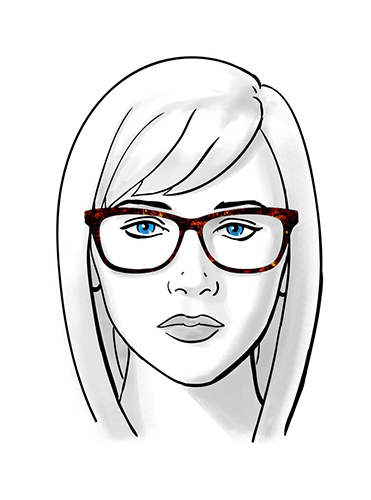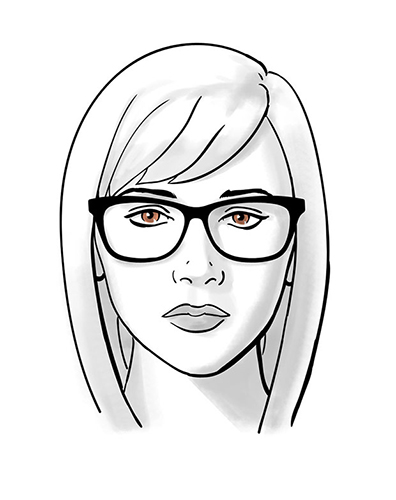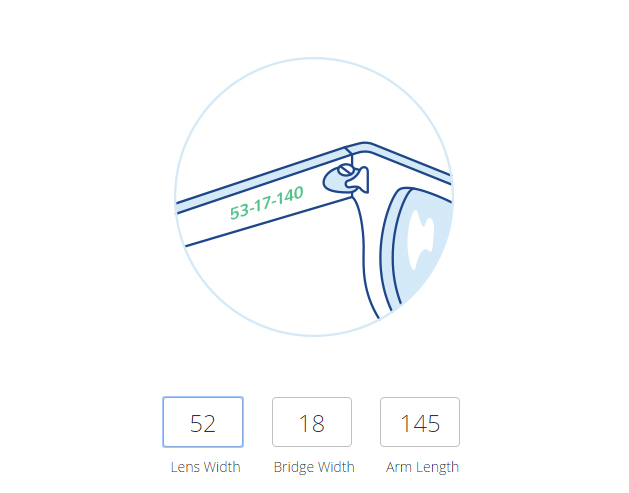Trying to find the perfect pair of glasses should feel fun, not frustrating. Your face shape, hair colour, eye colour, and personal style all play a part in determining the right frames for you. We’re here to lay out the guidelines, but ultimately rules were made to be broken: round glasses with a round face could be the perfect signature look, and red hair and red glasses might be just your thing.
This guide will help you understand how to weigh all of those factors as you make your choice. We’ll also encourage you to think about situation—are you looking for glasses to wear in a work setting, or for going out? Different frames may suit different occasions, or you can find a pair that looks good anywhere.
Shop By
Frame Size | Face Shape | Frame Color | Frame details
Finding your frame size

The better your frames fit, the better they flatter your face. Consider searching for your glasses as you would for a pair of shoes – first, you need to know your size.
Frame size incorporates three key figures, all of which are measured in millimeters.
Lens width: Between 31-60 mm
Bridge width: Between 12-31 mm
Glasses arm length: Between 115-155 mm
It’s easiest to find a pair of glasses that fit you already — whether they’re your current prescription pair, a set of sunglasses, or even your friend’s glasses (if you don’t yet have your own), and get the sizing from there. Usually, the frame manufacturer prints the size numbers on the inside of the arm of the glasses. Sometimes they’ll print them on the bridge. See the above image for reference.
Shopping by frame size
Once you have your measurements, plug them into MyFit. This tool will drastically narrow down your search to only frames that will fit you like your existing pair. Clearly sells thousands of frames, but with MyFit enabled you’ll only see the frames that fit you.
Interested to know how arm length and width further affects style and fit? Keep reading for more details.
Don’t see these numbers? We have a guide to measure them yourself.
Figuring out your face shape

You can read the full face shape guide here to figure out your closest match. Just know that — in general — there are particular frame shapes that go well with particular face shapes, and so these rules are mostly intended for people who want the most flattering option that requires the least amount of fuss.
Do you have a round face?

Traditional advice: find frames with bold, squared-off angles like rectangular, cat eye, and retro wingtip styles.
Want to make a bolder statement? Round glasses frames on a round face can be a stark style choice that stands out from the crowd.
Do you have a square face?

Traditional advice: Pick a frame that juxtaposes sharp angles — meaning curved styles like oval glasses, browline, round, and Aviator frames.
Want to make a bolder statement? Angular cat eyes and squared-off wingtip frames all starkly emphasize your features.
Do you have a triangular face?

Traditional advice: Pick a frame that’s widest and boldest on top, elongating a narrower forehead and balancing a wider jaw. Examples include browlines, Aviators, and cat eye glasses.
Want to make a bolder statement?
A round style offers an interesting juxtaposition to angular features.
Do you have a heart-shaped face?

Traditional advice: Pick a frame with a deep base — like the D-shaped lens of a retro wingtip frame. You’ll also want to choose pairs wider than your brow, making Aviators and cat eye frames another good option.
Want to make a bolder statement? If you have soft features, try rounded or oval metal frames for a classic 90s look.
Do you have an oval face?

Oval is considered the most “universal” face shape as almost all styles look good on oval face shapes due to their symmetry and balance.
Want to make a bolder statement? Try out any new trend first — Aviator glasses? Perfectly round metal styles? Chances are they’ll all look great.
Shopping by frame color
Most people gravitate toward neutral frames — black, brown, and tortoise — because they’re easy to match with just about any hair color, eye color, and skin tone. But if you’re looking to have a little more fun with your shade range, here’s our guide to choosing the frame color that makes you favorite features stand out.
Matching frames to eye color
Before deciding what frame color will work best with your eye color, ask yourself whether you want to stand out, or blend in. For a subdued, professional look, you’ll want frames that are a neutral color, or that match with your eye color.
But, for occasions more festive than the Monday Morning Meeting, you might want a different look. For your fun or casual glasses, choose a color that’s contrasting—but complementary—to your eye color.
Blue Eyes

Orange—the complementary color of blue—will really make your eyes pop. Tortoise-shell and brown glasses will also look good with blue eyes.
Brown/Amber Eyes

Any color will look great with your eyes, from classic black to brighter tones. If you want to stand out, choose a very bold color like a bright green or a pool blue.
Gray Eyes

Choose a colorful frame to avoid a monochromatic look. The good news is almost any brighter color will work with your eyes.
Green Eyes

Red is the complementary color of green, but you probably want to save that look for the holidays. We recommend brown or other earthy tones. These subdued frame colors always look good with green eyes. If you want to be bold, consider gold or purple frames.
Hazel Eyes

Hazel eyes often seem to switch from brown to green. So choosing green or brown frames both provide contrast and will blend in. Amber frames are also a good choice.
Matching frames to hair color
Hair plays by similar rules as your eyes: there may be certain shades you want to all-out avoid, but for the most part you’re looking to enhance and play around with your ideal palette.
Black Hair

For black hair, choose darker frames like black or tortoise shell. You can experiment with brighter colors, but whether they work will depend on your undertone.
White/Gray Hair

Go crazy! This is the ideal hair color for experimentation. Bright colors will look best with your hair.
Red Hair

Red hair calls out for bold frames. You can experiment with color, or, for a more conventional look, go with darker frames. Just avoid red frames, as they may blend in too much.
Brown Hair – red undertones

If you have brown hair with red undertones—also called auburn hair—you’re the perfect match with tortoise shell frames. Or look for frames that also have the warm, earthy colors of tortoise shell.
Brown hair – blonde/ash undertones

If your brown hair lacks red undertones, dark frames—especially black ones—will look terrific. You can also experiment with pastel colors.
Blonde Hair

If you have dark tones in your blonde hair, look for warm colors. Tortoise shell would also be a good choice for you. Ashy or platinum blondes—consider pastels and other bright colors for fascinating contrast with your light hair and skin.
Matching frames to skin tone
Cool
Noted for having a pink undertone, Cool skin types looks best with similarly cool-toned frames like blue, silver, gray, green, and clear. Black frames tend to be too harsh, while gold hues can clash with the naturally rosy complexion.
Neutral
Neutral skin types — with a mix of pink and golden undertones — can wear just about anything. Go bold with stark black, keep it neutral with a tortoise pattern, or play with any number of fun shades.
Warm
Accented with a golden undertone, warm skin types look best with similarly warm frames — tortoise, brown, red, orange, gold, and yellow. They also look great with the boldness of black, but will want to avoid greenish hues that may give them a sallow cast.
Shopping by frame thickness

Are you trying to make a fashion statement with your glasses, or do you want people to barely notice them?
Thick Frames
Thick frames are bold and unmissable. People with strong facial features like prominent noses or chins should think about trying thick frames, which will help de-emphasize those features. Thick frames usually come in dark colors, but as they’ve grown in popularity other options have joined the mix—clear thick frames are a cool and trendy look.
Thin Frames
Thin frames blend into your face. They emphasize your eyes and other facial features. If you want people to notice your face, not your frames—or if you don’t want to draw attention to your glasses—go for thin frames.
Shopping by frame width

The width of your frames is like the width of your shoes—this isn’t a fashion choice, it’s a matter of getting the correct fit. A couple of frame width fit rules to keep in mind:
1) There should be a gap between the arm of the glasses and your temple, but it should be a very small gap.
2) When you smile, the glasses should continue to rest on your nose, not get jostled by your cheeks.
Buying glasses online gives you a better range of styles and better prices, but it’s not that easy to determine fit without actually trying glasses on. That’s why Clearly offers free returns for 14 days from delivery. If your first choice doesn’t work, you can try a second (or third, or fourth…).
Shopping by arm width and length

Arm width
Don’t worry too much about the width of the frame’s arms. These are nearly always designed to be in proportion with the thickness of the frame overall. Thick arms usually go along with thick frames, and provide balance. They are most common on sunglasses. Most frames for regular glasses have thin arms.
Arm length

Frame length, however, is another matter. Most adult women want a frame arm between about 135-140, whereas most adult men should look for frame arms from 140-145. These figures vary depending on face shape and size.
Ready to get started?

You should now have all the information you need to find your perfect pair of glasses. If you’d like assistance, our Vision Care agents are available to answer any further questions about fit, style, and everything in-between at 1-866-333-6888.


































